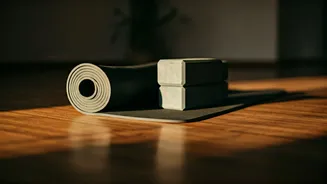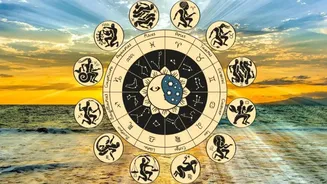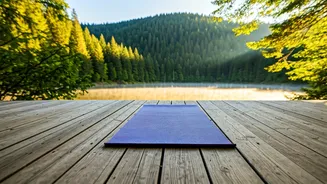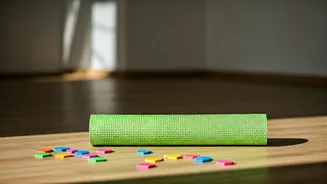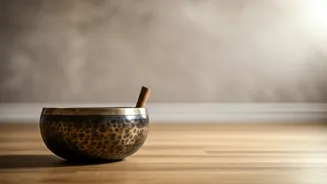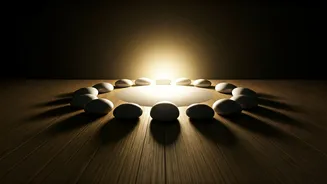Surya Namaskar Unveiled
Surya Namaskar, often referred to as Sun Salutations, is a sequence of 12 yoga poses that flows seamlessly together. This dynamic practice is traditionally
performed to greet the sun and is believed to invigorate the body and mind. Each posture in the sequence represents a different aspect of the sun's energy, working synergistically to bring about a holistic state of wellness. The practice is known to improve flexibility, strength, and balance, while also promoting mental clarity and reducing stress. Moreover, the rhythmic flow of Surya Namaskar has a meditative quality, making it a powerful tool for self-awareness and inner peace. The practice is often done at sunrise to align with the sun's energy, but it can be done at any time of day to revitalize and refresh the body.
Pranamasana: Prayer Pose
The journey begins with Pranamasana, or the prayer pose, where one stands tall with feet together, hands in a prayer position at the chest. This initial pose sets the intention for the practice and cultivates a sense of reverence. Deep breathing in this position helps center the mind and prepare the body for the sequence ahead. The prayer pose symbolizes respect and gratitude, prompting a moment of reflection before commencing the physical movements. By focusing on the breath and the gentle pressure of the palms, practitioners can begin to quiet the mind and establish a connection to their inner selves. This initial stillness is crucial for maximizing the benefits of the entire practice, creating a space for both physical and mental rejuvenation.
Hastauttanasana: Raised Arms
Next comes Hastauttanasana, or the raised arms pose. From the prayer pose, the arms are extended upwards, stretching the body towards the sky, often with a slight backward bend. This posture expands the chest and stimulates the lungs, promoting deeper breathing. It is believed to energize the body and uplift the spirit. As the arms stretch overhead, the spine is gently extended, enhancing flexibility and promoting good posture. The backward bend is done carefully, paying attention to the back and abdominal muscles, and avoiding overextension. This posture is also associated with a sense of freedom and lightness, opening the heart and inviting positive energy into one's life. The posture is essential to improve the breath flow and is known to be very therapeutic.
Hastapadasana: Forward Bend
The third pose is Hastapadasana, or the standing forward bend. From the raised arms pose, one bends forward, reaching towards the toes, keeping the legs as straight as possible. This asana stretches the hamstrings and lower back, promoting flexibility. It also calms the mind and can alleviate stress and anxiety. The head is allowed to hang down, releasing tension in the neck and shoulders. During this bend, the core muscles are actively engaged, and the breath becomes more controlled, supporting the forward folding. This pose is considered to be one of the best for releasing built-up tension in the body, which aids in relaxation. It gently compresses the abdominal organs, stimulating digestion and promoting overall metabolic health, making it an essential part of the sequence.
Ashwa Sanchalanasana: Lunge
Ashwa Sanchalanasana, or the equestrian pose, follows. One leg is moved back, placing the knee on the ground, creating a deep lunge. The gaze is towards the front, and the hands frame the front foot. This posture opens the hip flexors, stretches the thighs, and strengthens the core. It also builds strength in the legs and improves balance. The spinal extension in this pose helps stimulate the abdominal organs, promoting digestion and detoxification. It also activates the energy centers within the body. The lunge pose is a foundational position, often used in many other yoga sequences, due to its ability to improve balance and coordination, and it prepares the body for a deeper stretch.
Dandasana: Plank Pose
The fifth pose is Dandasana or plank pose. The other leg is moved back to meet the first, forming a straight line from head to heels, supported by the hands. This is a powerful pose that strengthens the arms, shoulders, core, and legs. It improves body awareness and stability. In this position, the body is aligned, engaging multiple muscle groups simultaneously. This position is ideal for creating core strength, and the core strength further supports the other poses in the sequence. It demands core engagement, promoting both physical strength and mental focus. The plank also prepares the body for more intense poses, developing control and balance, which are core elements for the entire Surya Namaskar sequence.
Ashtanga Namaskar: Eight Points
Ashtanga Namaskar, which means eight points of contact, follows the plank pose. The knees, chest, and chin touch the ground, with the hips lifted. This pose gently stretches the spine and strengthens the arms and shoulders. It is a moment of surrender and preparation for the following backbends. This pose, in which eight parts of the body touch the earth, offers a moment of grounding and stillness. The pose also helps improve breath awareness. It is a transitional pose, preparing the body for the subsequent backbend. This is often described as a moment of stillness amidst the dynamic flow, representing a pause that allows the practitioner to connect with the earth. It is often a brief pause before moving into the back-bending postures.
Bhujangasana: Cobra Pose
The next pose is Bhujangasana, or the cobra pose. The upper body is lifted off the ground, using the hands for support, while the lower body remains on the floor. This asana opens the chest and abdomen, stretches the spine, and strengthens the back muscles. It also stimulates the abdominal organs and improves digestion. In the cobra pose, the practitioner must ensure that the shoulders are relaxed, and the chest is opened. This posture aids in the relief of stress and fatigue, and it helps to stimulate the flow of energy throughout the body. The cobra pose is known for its ability to energize the body and is a crucial part of the Surya Namaskar sequence to maintain spinal flexibility.
Adho Mukha Svanasana: Downward Dog
Adho Mukha Svanasana, or downward-facing dog, is the next pose. The body forms an inverted V-shape, stretching the entire body and strengthening arms, legs, and back. This pose improves circulation and calms the brain, reducing stress and anxiety. It stretches the hamstrings, calves, and shoulders, improving overall flexibility. The downward-facing dog is a versatile pose, offering a combination of strengthening and stretching benefits. It is a resting pose and helps to ease out any tension felt. The downward dog is also beneficial for the digestive system and promotes mental clarity and peace, making it an essential asana in the Surya Namaskar sequence.
Repeat the Sequence
After Adho Mukha Svanasana, the sequence is repeated, mirroring the steps from Ashwa Sanchalanasana back to Pranamasana. This involves returning to the lunge with the other leg, then the forward bend, and so on. The repetition of these poses creates a flowing rhythm that enhances the practice. The return sequence to Pranamasana reinforces the benefits of the earlier poses, ensuring a balanced practice. Each complete cycle strengthens all parts of the body and mind. The repetitions deepen the benefits, leading to physical fitness and mental relaxation. Continuing through the sequence allows one to immerse themselves in the practice.
Benefits of 108 Repetitions
Performing 108 Surya Namaskars, as Neha Dhupia practices, amplifies the benefits of the sequence. This number is considered auspicious in yoga. The practice can significantly enhance physical and mental endurance, improve strength, flexibility, and promote a profound sense of well-being. It's a challenging but rewarding practice, with each repetition deepening the mind-body connection. The 108 repetitions can provide a comprehensive physical workout. With each cycle, the practitioner moves towards increased physical and mental equilibrium. It is an excellent practice for improving physical fitness and cultivating a meditative state and inner peace.
